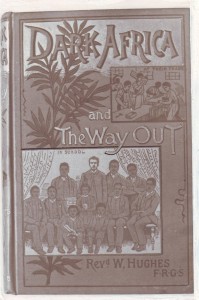
William Hughes (1856-1924) worked as a Baptist missionary in the Congo from 1882 to 1885, returning to North Wales with two African lads where Hughes developed the idea of training Africans in Britain, where they would be raised in a Christian environment and receive practical training from local tradesmen and professionals. This would enable them to become self-supporting missionaries in Africa. The Congo Institute was established in the resort town of Colwyn Bay, and the pupils who landed in Liverpool travelled on by coastal steamer.
Renamed the African Institute, it drew pupils and support from Africa and Africans, encouraged by Hughes touring West Africa in 1893 and the publication in 1892 of his Dark Africa: and the Way Out. Two daughters of Dutch and Congolese parents, Ernestina Francis (born c.1884) and Lulu Coote (born c.1891) were “half castes” according to the report of the Instititute for 1897-98, which shows Francis with 18 males in a photograph (she also appears in Dark Africa).
There had been 11 students in 1896-1897, including one American, Paul Daniels from Charleston, South Carolina. He was still there in 1897-98, with 18 others (12 new names since 1896-97), one of nine “industrial students” (ten studied a more academic curriculum including Greek, Latin, maths and geography). These young men came from Ghana, Nigeria, Angola, Sierra Leone, Cameroon, Liberia and South Africa. The three from Sierra Leone probably had Krio English as their mother tongue: all in all, at least seven African languages were spoken.
Mixing with others from so many different parts of Africa (and South Carolina) had an additional linguistic element, for Hughes had not spoken English until his teens, and locals spoke Welsh too: certainly chapel services were in Welsh. Adult visitors included John and Letitia Ricketts, from Jamaica, off to “Yorubaland” as missionaries, and ex-slave Thomas L. Johnson who had been a Baptist missionary in Cameroon and by the time of his visit to Colwyn Bay (1897-98 Report) lived in southern England. These black visitors surely stimulated the students?
The first African knight, Sir Samuel Lewis of Sierra Leone, pioneering Nigerian churchman Mojola Agbebi, Jamaica-born author Dr T. E. S. Scholes, and a Mr I. McPherson (who lived in Newport) were four other black supporters whose names have survived.
Daniels, sponsored by the Revd Daniel Jenkins of Charleston, studied printing, scripture, and book-keeping. There were lessons in “ambulance” (first aid), English grammar and composition, and shorthand. Daniels returned to South Carolina in late 1899, and spent many years assisting in the administration of the Jenkins Orphanage which had its own weekly black-focus newspaper, the Charleston Messenger (hardly any copies survive although it was published for 40 years).
By 1909 the African Institute had students from East Africa, from five locations in South Africa, from Botswana and from Grenada (West Indies), Bahamas, and Chattanooga, Tennessee – the latter, Joseph Morford, married Ernestina Francis and they worked in Nigeria. Lulu Coote was bound for Sierra Leone in 1914, having qualified as a nurse in Lancashire (see page 210). Ernestina Morford returned to Colwyn Bay to have her baby: they died there.
Hughes attacked the scandal-mongering John Bull of Horatio Bottomley, lost the libel case, and was bankrupt by mid-1912. Support for the Institute dried up. His life ended in the workhouse in Conwy in 1924: and his 80+ students had varied impacts in Africa – as educators, doctors, missionaries, printers and one carpenter.
See Hughes in the Oxford Dictionary of National Biography, and BBC Radio Wales “Past Master: The Congo Institute” broadcast 6 April 2007, and Institute reports at the National Library of Wales and the University of Wales, Bangor. “Sale Particulars of the Sale of the African/Congo Institute, Colwyn Bay” 1912, 1927 at Denbighshire County Council, Ruthin, ref DRO DD/PO/1103 – 1106, and “Dyn du o America yng Nghogledd Cymru or An American in North Wales”, paper presented by Jeffrey Green at the Charleston Jazz Initiative, 8 June 2007. Daniels who took the ‘African’ middle name Gabasie when in Wales, has a memorial plaque in the Charleston, S.C. church he ran for 23 years after the death (1937) of Daniel Jenkins. It declares he was born on 9 June 1872 and died 1 December 1961: and had also been president of the Jenkins Orphanage for 20 years.
Scandal at Congo House. William Hughes and the African Insitiute, Colwyn Bay by Christopher Draper and John Lawson-Reay was published in 2012 by Gwasg Carreg Gwalch at £9.50.